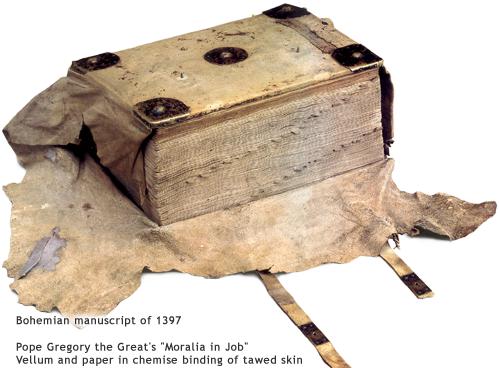

Before the introduction of modern methods of paper production, most European books were made of wood, metal and leather. They were heavy, bulky and expensive. Spell books are no exception; in fact, if anything, they tend to be even more expensive than their mundane brethren.
The example shown to the left, a medieval Bohemian manuscript of 1397, is the sort of thing one might expect to find in your average wizard's workroom. It's a no-nonsense book designed for the road — the loose soft leather flap is called a "chemise" binding, and is supposed to be wrapped around the body of the book to protect the edges of the pages from dust, dirt and the elements. The whole package is held together with straps, which in this case latch on to simple prongs on the front cover, though more elaborate latches and buckles were also commonly used.
 It consists of about a hundred leaves, of which the first twenty or so are paper (added at a later date than the main body of the book), and the remainder are vellum, which is a fine-grained unsplit lambskin, kidskin, or calfskin prepared especially for writing on or for binding books. The covers are of leather-bound wood, the vulnerable corners protected by brass plates. The dimensions of the book are roughly 8" x 12" (that's just a little narrower than the PHB, and a little taller) and about 4½" thick. It weighs just over thirteen pounds.
It consists of about a hundred leaves, of which the first twenty or so are paper (added at a later date than the main body of the book), and the remainder are vellum, which is a fine-grained unsplit lambskin, kidskin, or calfskin prepared especially for writing on or for binding books. The covers are of leather-bound wood, the vulnerable corners protected by brass plates. The dimensions of the book are roughly 8" x 12" (that's just a little narrower than the PHB, and a little taller) and about 4½" thick. It weighs just over thirteen pounds.
This would be an example of a "lowest common denominator" spell book. They may be substantially more elaborate than this one, and they may be much larger and much more expensive. Very valuable books would be likely to include cunningly designed latches and locks to keep out prying eyes and fingers, and covers may be made of exotic hides or metals. And, of course when you're dealing with wizards, there's always the likelihood of magical traps to contend with.
According to the PHB, any spell more potent than a cantrip requires the inscription of at least two pages (both sides of one leaf) per spell level. That means that the book shown here can contain a maximum of 100 spell-levels of spells.
Just to make that clear, if it were devoted entirely to 5th Level spells for example, it could contain a maximum of 20 spells (100 leaves divided by 5 leaves (10 pages) per spell). If it were full of 1st Level spells, you could cram 100 spells into it, and so forth.
There's no requirement to devote a spell book to a single level of spells; as long as the total number of spell levels written in the book doesn't exceed the number of leaves in the book, you can mix and match spells as you please.